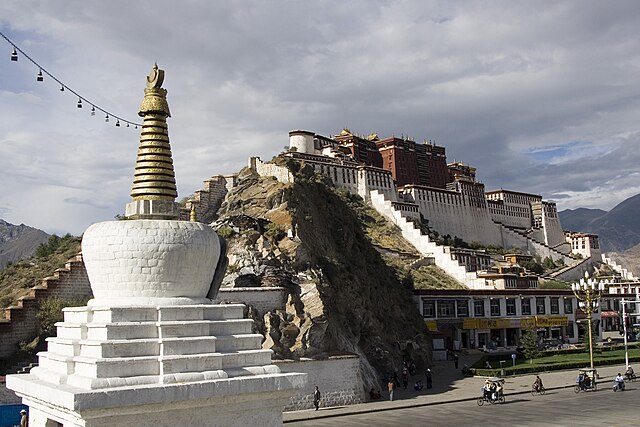Heinrich Harrer was an Austrian mountaineer, explorer, writer, sportsman, geographer, and SS sergeant. He was a member of the four-man climbing team that made the first ascent of the North Face of the Eiger, the "last problem" of the Alps. While on expedition in the Indian Himalayas, Harrer and his group were arrested by British forces because of the outbreak of World War II and he escaped to Tibet, staying there until 1951 and never seeing active combat. He wrote the books Seven Years in Tibet (1952) and The White Spider (1959).
Harrer in the 1930s
Eiger North Face, Bernese Alps, Switzerland
The Pargo Kaling chorten today (left), as reconstructed by Lhasa authorities.
Harrer in 1997
The Eiger is a 3,967-metre (13,015 ft) mountain of the Bernese Alps, overlooking Grindelwald and Lauterbrunnen in the Bernese Oberland of Switzerland, just north of the main watershed and border with Valais. It is the easternmost peak of a ridge crest that extends across the Mönch to the Jungfrau at 4,158 m (13,642 ft), constituting one of the most emblematic sights of the Swiss Alps. While the northern side of the mountain rises more than 3,000 m (10,000 ft) above the two valleys of Grindelwald and Lauterbrunnen, the southern side faces the large glaciers of the Jungfrau-Aletsch area, the most glaciated region in the Alps. The most notable feature of the Eiger is its nearly 1,800-metre-high (5,900 ft) north face of rock and ice, named Eiger-Nordwand, Eigerwand or just Nordwand, which is the biggest north face in the Alps. This huge face towers over the resort of Kleine Scheidegg at its base, on the eponymous pass connecting the two valleys.
The north face of the Eiger
The northeast side of the Eiger
Eiger
The Eiger with the Mönch and the Jungfrau







